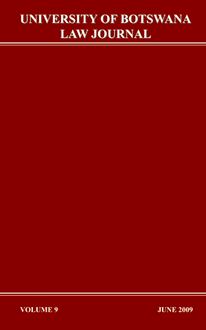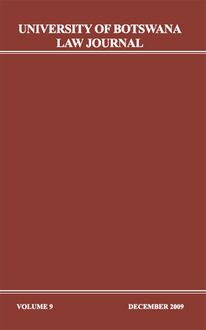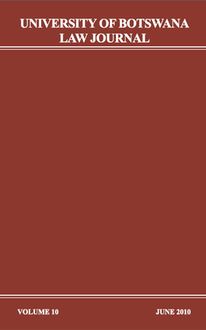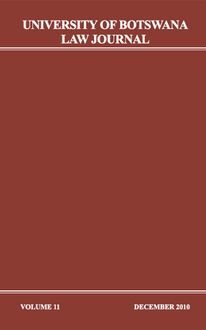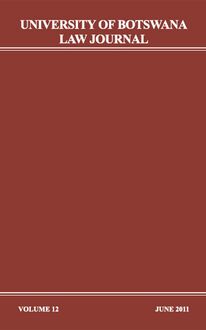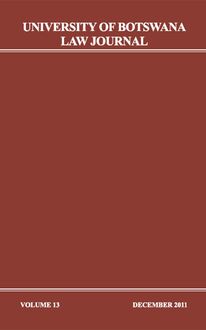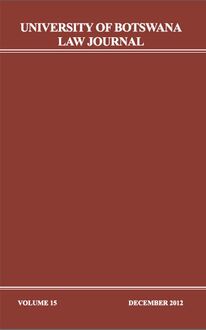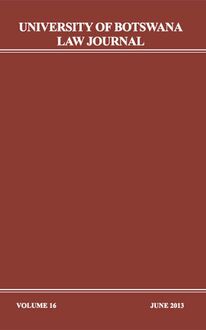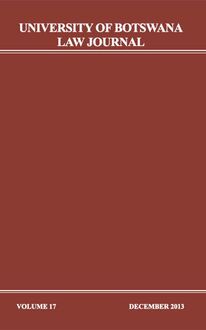The University of Botswana Law Journal is a peer refereed journal published twice a year. It provides a forum for scholars and practitioners to reflect on diverse legal issues of national, regional and international significance and of local and regional relevance.PatronThe Hon. Justice Nganunu, Chief Justice of BotswanaInternational Editorial Advisory BoardProf. D. D. N. Nsereko, Judge, International Criminal Court, The Hague, The NetherlandsProf. W. Du Plessis Faculty of Law, North-West University (Potchefstroom Campus), South Africa Prof. T. Maluwa H. Laddie and Linda P. Montague Professor of Law, Dickinson School of Law, Penn. State University, USA Prof. M. Reisman Myres McDougal Professor of Law, Yale Law School, New Haven, USA Prof. K. Frimpong Ghana Institute of Management and Public Administration, (GIMPA), Accra, Ghana Prof. S. Roberts Department of Law, London School of Economics, United Kingdom Prof. A. McCall Smith Edinburgh Law School, University of Edinburgh, United Kingdom Prof. C. Forsyth Faculty of Law, Robinson College, University of Cambridge, United Kingdom Prof. B. Othlogile Vice Chancellor, University of Botswana Dr. A. Molokomme Attorney-General, Botswana
Voir
UNIVERSITY OF BOTSWANA LAW JOURNAL
VOLUME 10 JUNE 2010
ARTICLES
The cultural defence and the custom ofThwalain South African law.......3 T.W. Bennett
Adjustment tensions and regime goals: A review of the WTO’s treatment of trade related environmental issues ...................................... 27 E.K. Abotsi
Sailing against the tide: Exhaustion of domestic remedies and the ECOWAS Community Court of Justice ...................................................57 A.O. Enabulele
Globalisation and its failure: Implications for governance and human rights in Africa ..........................................................................................77 Z. Maundeni
Botswana
South Africa
RECENT LEGAL DEVELOPMENTS
-
-
E.N. Macharia-Mokobi..................91
S. Heleba........................................97
BOOK REVIEW
Fundamental Perspectives on International Lawby William R Slomanson - E.N. Macharia-Mokobi................109
2 UNIVERSITY OF BOTSWANA LAW JOURNAL JUNE 2010
ARTICLES
3
The cultural defence and the custom ofThwalain South African law
ABSTRACT
T.W. Bennett*
South Africa’s democratic constitution dramatically improved the position of customary law in two ways. It obliged all courts to apply customary law, when that law is applicable, subject to limitations by the Constitution and specific legislation dealing with customary law. It also gave every person the right to participate in a culture of choice. This dispensation seemed to allow members of a minority culture to invoke cultural defense to secure acquittal or at least mitigate least culpability, on the ground that their cultural norms were the reason for criminal conduct. This article examines the applicability of the cultural defence with reference to the African custom of ukuthwala – a form of abduction preparatory to marriage- against the backdrop of the highly publicised prosecution of South Africa’s Jacob Zuma, for the alleged rape of a 31 year old daughter of a family friend. The paper postulates thatwhile a cultural defence was not invoked,the case nevertheless pointed to certain serious concernsabout its desirability in South Africa law. In particular, the writer contends thatserious attention needs to be given to a conception of culture with potentialfor extemporized and opportunistic self-serving constructions of culture.The paper advocates the view that ultimate protection against makeshift self-interested manipulation of culture must be sought in the Constitution which has in-built curbs such as the requirement that the customary practice in question – such as thwala – would not pass constitutional muster unless it was proven to be justifiable and essential in a constitutional democracy.
1.
INTRODUCTION: CULTURE AND CRIME
Over a period of hundred and fifty years, amodus vivendi was gradually worked out for South Africa’s indigenous customary laws and the imported colonial laws. But the relationship was hardly an equal one. The two systems finally came to be treated on a par only with the arrival of a democratic 1 constitution. The new dispensation had the effect of dramatically improving the
* 1
Professor of Law, University of Cape Town. SeeAlexkor Ltd and anothervRichtersveld Community and others2003 (12) BCLR 1301 (CC) at para. 51 andBhe and othersvMagistrate Khayelitsha and others2005 (1) SA 580 (CC) at para.s 14-15.
4 UNIVERSITY OF BOTSWANA LAW JOURNAL JUNE 2010
position of customary law. On the one hand, section 211(3) of the 1996 Constitution obliged all courts to “apply customary law, when that law is applicable, subject to the Constitution and any legislation that specifically 2 deals with customary law”. On the other hand, sections 30 and 31 gave every 3 person the right to participate in a culture of choice. Because customary law was closely identified with African cultural traditions, the courts accepted that 4 its application rested on the constitutional guarantee of culture. In light of these provisions, one might be forgiven for thinking that the relationship between customary and common law was finally settled, but an area still to be explored is criminal law. In this regard, an issue that invites serious consideration is what Anglo-American jurisdictions term a “cultural 5 defence”. This defence allows members of a minority culture to argue that they should be completely acquitted of criminal charges, or their culpability be at least mitigated, on the ground that their cultural norms were the reason for the commission of the crimes. A critical issue in the cultural defence is a distinction between dominant and minority cultures. The principal arm of state control is criminal law. It encodes the state’s dominant cultural values, and is deemed applicable to everyone. The dominant regime is therefore extended to the entire 6 population, regardless of the values and practices of minority groups. The cultural defence is aimed at extending some recognition to thes minority regimes. In the overseas jurisdictions, where the cultural defence was first 7 argued, minority cultures generally attracted no formal recognition. Nevertheless, an argument for the cultural defence has been steadily 8 developing since the 1980s. Our courts, on the other hand, have never
2
3
4
5
6
7
8
This provision means that, when the choices of law rules indicate the applicability of customary law to the facts of a particular case; the courts are bound to apply that law, although always subject to the Constitution and any relevant legislation. Section 30 provides that: “[e]veryone has the right to … participate in the cultural life of their choice”. Section 31(1) provides that: “[p]ersons belonging to a cultural, religious or linguistic community may not be denied the right, with other members of that community - (a) to enjoy their culture ….” T.W. Bennett,Human Rights and African Customary Law Under the South African Constitution,Juta & Co (1995), p.23. In the civil-law jurisdictions, the preferred term is “cultural offence”: J. van Broeck, “Cultural Defence and Culturally Motivated Crimes (Cultural Offences),” (2001) 9European J of Crime, Criminal L & Criminal Justice,p.1. See, too, M-C. Foblets, “Cultural Delicts: The Repercussions of Cultural Conflicts on Delinquent Behaviour. Reflections on the Contribution of Legal Anthropology to a Contemporary Debate,” (1998) 6European J of Crime, Criminal Law & Criminal Justice,p.187 at p.187ff. While the situations in which a cultural could be asserted seldom occur, when they do, they generally attract much publicity and arouse strong feelings: Van Broeck (n 5) op.cit. p.19. See, for instance the Zuma rape trial which is dealt with at the end of this article. As J. Waldron, “One Law for All? The Logic of Cultural Accommodation,” (2002) 59Washington & Lee L Rev, p.3 at p.14 remarked: “many of the regulations to which cultural offense is taken are not laws like those prohibiting … killing … but laws governing (supposedly in the interest of the governed) the detailed way in which ordinary life is led. … for which ordinary citizens have greater or lesser enthusiasm. Many of these laws are paternalistic, and many cultural challenges to them amount in effect to anti-paternalistic critiques.” Indeed, the communities in question were not fully integrated into the state: L. Volpp, “(Mis)identifying Culture: Asian Women and the ‘Culture Defense’,” (1994)Harvard Women’s LJ,p.57 at p.61. Proposals first emerged in American academic literature in response to a series of prosecutions of Asian immigrants and refugees in California. The doctrine has also been applied to Native Americans (a signal
CULTURAL DEFENCE AND THE CUSTOM OFTHWALAIN SA LAW5
9 entertained a defence of this nature, an odd omission, because culture has, on 10 several occasions, been argued in this manner, and, of course, African customary law has long been accepted as part of our legal system. There are probably two reasons for this oversight: relaxation of the 11 ruleignorantia iuris haud excusat, which is explored more fully below,and the British attitude to matters of indigenous culture in their former African colonies. Throughout the empire, European or settler culture was taken to be the standard to which everyone should aspire. While African customary law was tolerated, its application was allowed only with reservation. In South Africa, the most convenient place at which to start an 12 account of customary law is the Law of Evidence Amendment Act. It provides that: “Any court may take judicial notice of … indigenous law in so 13 far as such law can be ascertained readily and with sufficient certainty ...”. 14 The term “indigenous law” here is defined broadly by the Act to mean the “Black law or customs as applied by the Black tribes in the Republic or in 15 territories which formerly formed part of the Republic.” Notwithstanding the generous scope of these two provisions – which becomes even more extensive when read with section 211(3) of the Constitution – the magistrates’ courts and the High Court have always operated on an unspoken assumption that, for criminal matters, only the 16 common law is applicable. Customary law is thus, by implication, confined to the private sphere. In this respect, South Africa conforms to a pattern that was set for all parts of anglophone Africa: while the colonial powers were prepared to apply indigenous systems of customary law, the terms of 17 recognition did not contemplate criminal justice and public administration.
8
9
10
11 12
13
14 15 16
17
irony). There is, as yet, however, no special rubric for a cultural defence in the United States, which has meant that offenders are obliged to argue their cultural circumstances under the existing defences available in the criminal law. See, in this regard, J.P. Sams, “The Availability of the ‘Cultural Defense’ as an Excuse for Criminal Behavior,” (1986) 16Georgia J of Int & Comp L,p.335 at pp.338ff. Cf P. Carstens, “The Cultural Defence in Criminal Law: South African Perspectives,” (2004)De Jure, p.312. See, for example,R.vMatomana1938 EDL 128 at 131,R.vNjikelana1925 EDL 204 andPhirivR. 1963 R&N 395 (SR). Following the decision inS.vDe Blom1977 (3) SA 52 (A). Section 1(1) of 45 of 1988. This section replaced section 11(1) of the Black Administration Act 38 of 1927, which had even earlier colonial antecedents. This sentence is then followed by a notorious, although seldom invoked, claw-back clause: “provided that indigenous law shall not be opposed to the principles of public policy or natural justice …”. Although the repugnancy clause had the potential of severely restricting recognition of African culture, it was not often used: N.S. Peart, “Section 11(1) of the Black Administration Act No 38 of 1927: the Application of the Repugnancy Clause,” (1982)Acta Juridica, p.110 at p.116. Which may be understood to mean the same as “customary law”? Section 1(4) of the Law of Evidence Amendment Act. The powers of traditional courts, on the other hand, were conceived differently. Under sections 12(1) and 20(1) of the former Black Administration Act 38 of 1927, approved chiefs or headmen could hear civil and certain minor criminal disputes arising amongst “blacks” within their areas of jurisdiction according to customary law. Although most of this Act was repealed by Act 28 of 2005, implementation of the measures affecting the traditional courts was delayed until the promulgation of new legislation. Although a Traditional Courts Bill B15-2008 finally appeared on 9 April 2008, it has not yet been translated into legislation. To have recognised the indigenous criminal law would have contradicted a basic function of the legal system, which was to proclaim the values of British civilisation and the reach of state power. See M.
6 UNIVERSITY OF BOTSWANA LAW JOURNAL JUNE 2010
18 In these areas, metropolitan law was the overriding system. This policy was determined by a pervasive idea that the public and private spheres of life could, and should, be kept quite separate. Customary law (and African culture) held sway in the sphere of domestic relationships, but, in the public realm, colonial laws and values were to provide uniform 19 standards for everyone in the state. Hence, little or no attempt was made to accommodate African culture in the criminal justice system. In the paper below, I will examine the applicability of the cultural defence with reference to a typical African custom, the practice of ukuthwala. This is a form of abduction preparatory to marriage.
2.
THWALA AND ITS VARIANTS
Ukuthwala is a widespread practice, although it is especially associated with the so-called Nguni cultures of the Eastern and South-Eastern regions of South Africa. Marriage here is virilocal, since the bride must go to live with the groom at his place of residence. Given a strong principle of clan exogamy, and a dispersed mode of family settlement, the forging of marital relationships requires careful negotiation to bridge the physical and social distance between 20 families. The conventional methods for opening marriage negotiations require an intermediary to initiate proceedings by taking a formal proposal from the groom's family to the prospective wife’s family, together with gifts as earnest 21 of serious intent. If the proposal came from the bride or her family, the procedure would be considered 'irregular' (although this term did not necessarily imply unlawful). One such irregular mode was for the girl’s family to open the negotiations. Such a 'reverse proposal' might be employed 22 if the girl was of high rank but, for various reasons, had attracted no suitors. 23 More common forms of irregular proposal allowed the girl herself, usually
17
18
19
20
21
22
23
Chanock,The Making of South African Legal Culture 1902-1936; Fear, Favour and Prejudice, Cambridge University Press (2000), p.48. T.W. Bennett,Application of Customary Law in Southern Africa, the Conflict of Personal Laws, Juta & Co (1985), p.40. On occasion, when circumstances seemed appropriate, there were departures from this policy, as in the case of the former Bechuanaland. In 1885, Britain declared Southern Bechuanaland a Crown colony and Northern Bechuanaland a protectorate. Because these areas were sparsely populated and remote from areas of colonial settlement, traditional rulers were left more or less to their own devices. They were given exclusive civil and (apart from certain serious crimes) criminal jurisdiction: sections 31 and 32 of Proclamation 2 of 1885. See A. Kuper,Wives for Cattle; Bridewealth and Marriage in Southern Africa, Routledge & Kegan Paul (1982), pp.134-137ff. for a comparison of Nguni and Sotho-Tswana marriage practices. See H. Ngubane “'Marriage, affinity and the ancestral realm: Zulu marriage in female perspective” in E. J. Krige & J. L. Comaroff (eds.),Essays on African Marriage in Southern Africa, Juta & Co (1981), p.84 at p.84 on the Zulu conception of marriage. W.A. Hoernlé “Social Organisation” in I. Schapera (ed.),The Bantu-speaking Tribes of South Africa, Maskew Miller (1956), p.67 at p.112. See further E.J. Krige,The Social System of the Zulus,Longmans Green (1936), pp.128-131, J. Van Tromp,Xhosa Law of Persons: A Treatise on the Legal Principles of Family Relations among the
CULTURAL DEFENCE AND THE CUSTOM OFTHWALAIN SA LAW7
with the collaboration of her suitor, to take the initiative. In the case of baleka [lit. running away], the girl made the first move, generally because her situation required urgent action. She might have been promised in marriage to one man, but had fallen in love with another. To avoid the arranged marriage, the girl would steal off to her preferred mate after dark. If his family decided to accept her, they could set in motion the 24 procedure for a regular proposal. Thwala is a more common irregular mode. It generally takes the form of a mock abduction, whereby a suitor and his friends ‘kidnap’ the girl 25 and carry her off to his homestead. The suitor need not himself participate, since the event might be organised by his friends or even by the girl’s 26 guardian. The ‘kidnapping’ party would wait until early evening, when the girl could be waylaid and taken off to the suitor’s homestead. She might be caught unawares, or she herself might be in on the plot. In either event, she would be expected to put up a show of resistance, for to acquiesce willingly 27 would be to show a lack of maidenly pride. The day following the thwala, the men responsible for the event should report what happened to her guardian, so as to allay any fears about her safety. They should, in addition, tender earnest cattle or lobola, and thereby place the incident on the level of a formal marriage proposal. If the girl’s family were to accept the proposal, further negotiations could proceed. If not, the thwala would be deemed wrongful – although far from criminal – and the 28 suitor (or more probably his father) would have to pay bopha[a fine]. The custom of thwala did not contemplate sexual intercourse, at least not until the girl’s status as a bride had been duly fixed. Traditionally, as soon as she arrived at the suitor’s homestead, she would have been placed under the care of the women in his family. If the suitor were to have sex with her, he would be required to pay seduction damages in addition to the lobola cattle or
23
24
25
26
27 28
AmaXhosa, Juta & Co (1947), pp.63-67, J.H. Soga,The Ama-Xosa: Life and Customs, Lovedale Press (1931), pp.271-272, A. ReuterNative Marriages in South Africa, according to Law and Custom, Aschendorffsche Verlagsbuchhandlung Münster (1963), pp.142ff. and J.F. Holleman,Shona Customary Law, Oxford University Press (1952), pp.121-123. D.H. Reader,Zulu Tribe in Transition-the Makhanya of Southern Natal, Manchester University Press (1966), pp.188-189 reported, however, that baleka was on the decline. See G.M.B. Whitfield,South African Native Law, 2ed, Juta & Co(1948), pp.115-116, Van Tromp (n 23) 63ff., H. Ashton,The Basuto, Oxford University Press (1952), p.65, H.J. Simons,African Women; Their nd Legal Status in South Africa, C Hurst(1968), pp.117-119 and M. Hunter,Reaction to Conquested.,, 2 Oxford University Press (1961), pp.187-188 and 531-532. D.S. Koyana & J.C. Bekker, “The IndomitableUkuthwalaCustom” (2007)De Jure,p.139 at p.141, citing MkokobanevMngqumazi1947 NAC (C&O) 41 (regarding the absent suitor) andDyongovNani2 NAC 102 (1911) (regarding the girl’s guardian). Koyana & Bekker (n 26) op. cit. 139. See, too,MkupenivNomungunya1936 NAC (C&O) 77. Sakankav Totsholo1945 NAC (C&O) 11. See Hunter (n 25) p.188, Van Tromp (n 23) pp.66ff. and Simons (n 25) p.118. However, section 101 of the Natal and KwaZulu Codes Proclamation R151 of 1967 and Act 6 of 1981, respectively, (both now repealed by Act 28 of 2005) provided that, although damages are usually payable for abducting the child or ward of another, no action lies if the individual concerned was absent “in connection with the betrothal visit of a girl to the family home of a proposed future husband”.
8 UNIVERSITY OF BOTSWANA LAW JOURNAL JUNE 2010
29 bopha. Indeed, couples considering thwala would be aware that, unless handled carefully, it could become an actionable delict, since it amounted to 30 violation of a guardian’s control over his children. 31 The reasons for resorting to thwala were many, and its popularity is perhaps easier to understand when thought of not as an abduction (which has 32 too many negative connotations) but rather as an elopement. Thwala typically prefigured a love match between a girl and her lovelorn swain. The 33 couple might then want to force the girl's father to consent; they might want 34 to avoid the expense of a wedding, or to hasten matters, if the girl were pregnant. Alternatively, ardent suitors might resort to thwalaof their own 35 accord in order to persuade the girl’s family of their serious intent. Thwala used to be prevalent amongst migrant workers, who would elope with their girlfriends during home visits so that they could circumvent the costs and formalities of a regular proposal, not to mention the possibility 36 of having to pay the first instalment of lobola.The woman's guardian himself might have actively connived in the plan. The reason for his participation was usually economic, because, for a cash-strapped father, the 37 thwala of a daughter promised an immediate form of income.
3.
THE STATE’S ATTITUDE TO THWALA
Notwithstanding the popularity of thwala, it was unacceptable by western standards, when the girl was forced to participate. But, as was evident above, it is not always easy to determine whether she was a willing partner when 38 convention dictated that she should feign reluctance. It was to be expected, then, that the colonial courts would be on their guard.
29 29
30
31
32
33 34 35 36
37
38
Molisanav Leqela2 NAC 189 (1911),Sikemele and anotherv BambizuluNAC 1 (1920), 4 Nyilav Mnyama4 NAC 2 (1922) andMagqabivMakolwana1933 NAC (C&O) 3. The wrong is actionable under both customary and common law. Under the former, however, the girl has no cause of action, whereas she does under the latter:MkupenivNomungunya1936 NAC (C & O) 77 at p.78. P. Whooley “Marriage in Africa: A Study in Ciskei” in T.D. Verryn (ed.),Church and Marriage in Modern Africa, Ecumenical Research Unit, Greenkloof (1975), pp.295ff. In the western tradition, elopement signifies a couple’s escape from the formalities required of marriage at the place of their domicile, notably, the need for their parents’ consent. Koyana & Bekker (n 26) p.143 say that: “For an open-minded observerthwalais indeed a charming, romantic practice.” Dhlamini and anothervMkize1929 NAC (N&T) 118. Van Tromp (n 23) pp.67-68 and Soga (n 23) p.272. ShabanguvNkosi1941 NAC (N&T) 118. Before the days of migrant labour, the prospective husband’s father would have provided the lobola, but today it is usually the husband himself who bears this responsibility - which is an added inducement to resort to thwala. See C.W. Manona “Marriage and family life in a Ciskeivillage” in P. Mayer (ed.),Black Villagers in an Industrial Society, OUP(1980), p.169 at pp. 189-193. Apparently, from the 1920s until the 1940s, a custom of “indicating the toe” was quite common: a father would offer his daughter in marriage as security for advances in food and cash, and, when the girl reached marriageable age, she would also bring lobola. See D. Posel, “State, Power and Gender: Conflict over the Registration of African Customary Marriage in South Africa c. 1910-1970,” (1995) 8J Historical Sociology,p. 223 at p.242. Hunter (n 25) pp.187-188, Holleman (n 23) p.110 and Van Tromp (n 23) pp.70-71. See the interesting contemporary case cited by Koyana & Bekker (n 26) p.140, and, in addition, A. Phillips & H.F. Morris,
CULTURAL DEFENCE AND THE CUSTOM OFTHWALAIN SA LAW9
Customary law treated marriage as an agreement between families, to be negotiated by senior males and sealed by payment of lobola. Strictly speaking, the views of the bride were irrelevant. The colonial authorities, 39 however, insisted on the full consent of both spouses. In consequence, any customary marriage contracted without the spousal consent was deemed 40 “repugnant to our civilized conscience”. It was, in fact, unusual in African custom for young people to be forced to marry, because everyone was well aware that unhappy matches ultimately resulted in discord, with unhappy implications for the whole 41 family. Moreover, the rituals of courtship and the complex marriage 42 negotiations gave brides-to-be a fair opportunity to voice their objections. By the 1920s onwards, however, it was clear that respect for these traditions 43 was waning. While the authorities were, at that stage, keen to revive African 44 45 tradition, they were not prepared to give up the cause of women. The 46 courts therefore continued to insist on proper consent to marriage, and held that thwala was not to be used “as a cloak for forcing unwelcome attentions on 47 a patently unwilling girl”. The suitor who had resorted to thwala could be
38
39
40
41
42
43
44 45
46
47
Marriage Laws in Africa, Oxford University Press (1971), p.99 and Wilson in Krige & Comaroff (n 21) p.136. See, in this regard, Shepstone’s policies in colonial Natal: Cape of Good HopeReport and Proceedings of the Government Commission of Native Laws(1883) para. 570 p.32, cited by Posel (n 37) p.227 fn9. Zimandev SibekoNAC 21 (C) at 23. See, too, 1948 Zuluv Mdhletshe 1952 NAC 203 (NE) and MngomezuluvLukele1953 NAC 143 (NE). CfNeku and anothervMoni1938 NAC (C&O) 61, however, where the marriage was by the husband's proxy, andMchunuvMasoka 1964 BAC 7 (NE). Cf. S.B. Burman in R. Hirschon (ed.),Women and Property/Women as Property, Croom Helm, London (1984), p.120. nd Whitfield (n 25) p.87, I. Schapera,A Handbook of Tswana Law and Customed., Oxford University, 2 Press (1955), p.129 and Simons (n 25) pp.102-103. Social conditions in the burgeoning urban areas were dire, and many of the problems were attributed to unstable marital relations, caused in part by the “drift of undesired and undesirable females to the urban centres”. Posel (n 37) pp.228 and 229. Women were not necessarily seen as victims. As Posel op. cit. p.241 says: “Left to their own devices, African women were considered sexual predators ... Seen as lacking any capacity for self-control, such women were represented as having ‘run wild’ – until subject to the authority of a man.” Bennett (n 18) p.46. Even so, patriarchal privilege was an area in which African men were most determined to defend the integrity of their culture. See the discussion by Posel (n 37) in general, especially at p.225. Thwala became something of a battleground (Posel (n 37) p.227), a situation that was exacerbated by a steady increase in the practice: from 14.6% of all marriages in the 1920s, thwala accounted for 18.3% in the 1930s, 30.3% in the 1940s and 55.9% in the 1950s: T. W. Bennett,A Sourcebook of African Customary Law for Southern Africa,Juta & Co (1991), p.190. NomatusivNompetu3 NAC 165 (1915),Mpangalala and anothervNjijwa5 NAC 14 (1924),Gempeza v Ntsizi 5 NAC 103 (1926),Sibekov Malaza 1938 NAC (N&T) 117,Mbangav Sikolake 1939 NAC (C&O) 31,GidjavYingwane1944 NAC (N&T) 4,GebeleisenivSakumani1947 NAC (C&O) 105 and ZimandevSibeko1948 NAC 21 (C) at 23.R.vMane1948 (1) SA 196 (E) held that forcing a woman to marry against her will is not necessarily a crime, unless she was also compelled to have sexual intercourse. Now the matter is governed by section 12(2) of the Children’s Act 38 of 2005 which provides that: “A child (a) below the minimum age set by law for a valid marriage may not be given out in marriage or engagement; and (b) above that minimum age may not be given out in marriage or engagement without his or her consent.” Mkupeniv Nomungunya1936 NAC (C&O) 77. Any forced unions were declared null and void: Gebeleiseniv Sakumani 1947 NAC (C&O) 105. CfMkupeniv Nomungunya1936 NAC (C&O) 77. Specific legislation to this effect was passed in Natal and Transkei: section 116(1)(b) of the Codes on Zulu Law Proclamation R151 of 1967 and Act 16 of 1985, respectively, and section 30 of Proclamations
10 UNIVERSITY OF BOTSWANA LAW JOURNAL JUNE 2010
sued for damages in delict or prosecuted for the commission of the crimes of 48 abduction, rape or assault. The origins of these criminal and delictual actions go back to 49 antiquity, which, in the case of South Africa, of course, meant Roman law. The victim of the offence, however, was not the woman but rather her guardian, because it was hispatriapotestas (the right of control over family 50 members) that had been violated. This line of thinking was handed down to 51 Roman-Dutch law. Relying on Dutch authority, the South African courts readily 52 accepted abduction as a crime against the powers of guardianship, in 53 particular, the power to approve a minor’s marriage. The female victim’s interests were taken into account only by way of holding that, the older she 54 happened to be, the less severe the punishment. Whether the girl consented to the offence or not was irrelevant, even if the abductor’s intention was not 55 marriage, but sexual intercourse. This somewhat perverse thinking presented the courts with the difficult task of distinguishing abduction from the delict of seduction. They solved the problem by a requirement, for a charge of abduction, of an intention both to seduce the woman and to take her “permanently and for a 56 substantial period” out of her custodian’s control. In effect, therefore, the
47
48 49
50
51
52
53
54
55 56
110 and 112 of 1897 and section 29 of Proclamation 140 of 1885. Guardians who coerced their wards into marriage were guilty of an offence. See further Phillips & Morris (n 38) p.100. See Posel (n 37) p.242 and thecause célèbreof 1946 she cites. As with many early cultures, it seems that Roman law allowed men to obtain their wives by forcible capture. Indeed, according to the famous foundation myth, Rome’s first generation of men acquired their brides by “raping” the women of the neighbouring Sabines. Titus Livius,Ab Urbe Condita(translated as The Early History of Rome, by A. de Sélincourt, Penguin Classics (2002))1, 9-13. Several centuries later, however, under a statute of Justinian, heavy penalties were imposed forraptus, which denoted the asportation of a woman for purposes of marriage or sexual intercourse: Codex 9.13. Neither violence not the absence of the woman’s consent was deemed relevant: Codex 9.13.1.3. Under Germanic law, too, the abduction of females was considered an offence against the woman’s father. Because the abductor had flouted parental power (mundium), he was likened to a thief: J. Burchell & J. rd Milton,Principles of Criminal Lawed., Juta & Co. (2005), p.762., 3 S.vTobie(1899) 16Cape LJ45 at p.49. The asportation of the girl was not an accepted method for constituting a valid marriage, because the bride’s father lost his bride price. Burchell & Milton (n 50) op.cit. p.764, citingTobie’scase supra at p.48 andR.vHlapo1944 OPD 166 at pp.172-173. Some of the jurists, such as J. VoetCommentarius ad Pandectas (1647)(translated by P. Gane Butterworth & Co (1955)) 48.6.4, gave the impression thatraptusremained a crime when a minor was removed without a guardian’s consent for purposes of marriage or sexual intercourse (with or without the woman’s consent). Others, such as D.G. Van der Keessel,Praelectiones ad Jus Criminale, Vol 2 (edited and translated by B. Beinert & P. van Warmelo, Juta & Co. (1972)), p.883, give the impression thatraptus was a crime only when forcible. “Ontvoering”was a separate offence, and was committed when a female minor was removed with her consent for purposes of marriage. See P.M.A. Hunt,South African Criminal Law and Procedure,Vol 2Common-Law Crimes, Juta & Co. (1970), p.540 and the cases cited there, especiallyS.vKillian1977 (2) SA 31 (C) andS.vL1981 (1) SA 499 (BSC) at p.502. See section 3(3)(a) of the Recognition of Customary Marriages Act 120 of 1998 and section 24 of the Marriage Act 25 of 1961. R.vThomas1925 EDL 248 at p.253. Note, however, that if the girl removes herself from her guardian’s control without his permission and with the assistance of her suitor, no crime is committed: Hunt (n 52) p.541 fn51. R.vChurchill1959 (2) 575 (A) at p.580. See, for instance,R.vHanna1937 TPD 236 at p.240.
CULTURAL DEFENCE AND THE CUSTOM OFTHWALAIN SA LAW11
57 58 essence of the crime was the unlawful removal of a child, with or without her (or potentially his) consent, for purposes of sexual intercourse or marriage 59 with the abductee. In spite of changes in the status of women and children in modern 60 times, the Roman-Dutch crime still exists in the common law (together with 61 62 an antiquated delict). Prosecutions, however, have been relatively few. (From the reported cases, it appears that most were brought against men engaged in the custom of thwala or one of its variants.) Remarkably, it is still 63 the rule that neither the girl’s consent nor her guardian’s is of any account. 64 The court, inR. v Sita,reasoned that it would be strange if the abductor could take away a girl, and, by doing so, force her guardian to consent to the situation either to avoid a scandal or to avoid further harm to his daughter. If thwala involves an undue use of force, then, in addition to a charge 65 66 of abduction, the offender could face one of assault. InR.vSwaartbooi, for instance, the court commented that it would not “recognise the barbarous custom oftwalaing” as a defence to a charge of assault that might have been committed against the girl (or her friends and relations) who tried to resist attempts made by the suitor and his party to abduct her. Even more seriously, the offender could be charged with rape, if he 67 68 coerced the girl into having intercourse. InR.vMane,for example, a girl's guardian gave permission to the accused's brother for her to be taken by thwala for the purpose of marriage, although she knew nothing about the plan. When she realised what was happening, she refused to cooperate, and vainly tried to escape. Her guardian told her not to “act foolishly but to obey”, and to 69 stay with the accused. During this time, the offender twice coerced the girl
57
58
59 60
61
62 63 64 65
66 67
68 69
Which may be actual physical removal, or constructive, i.e., when the offender persuades the woman to leave her family: Burchell & Milton (n 50) p.765. Children are deemed to be all those below the age of 18 years: section 17 of the Children’s Act 38 of 2005. Note, however, that abduction in common law also refers to the asportation of aspouse:Pearcev Kevan1954 (3) SA 910 at 912. See generally V.V. Palmer,The Roman-Dutch and Sesotho Law of Delict, Sijthoff, (1970), pp.157ff. Burchell & Milton (n 50) p.762. It may be distinguished from kidnapping, which is aimed at extorting money. Note that, under sections 70(1) and (2) of the Criminal Law (Sexual Offences and Related Matters) Amendment Act 32 of 2007, the removal or receiving of a person “within or across the borders of the Republic” by means of a threat or use of force or abduction will constitute the crime of trafficking. nd See Voet (n 51) 48.15, J. Neethling, J. M. Potgieter & P.J. Visser,Law of Delict, 2 ed., LexisNexis th Butterworths (2006), p.327 and R.W. Lee,An Introduction to Roman-Dutch Law,4 ed., Clarendon Press (1946), p.336, who notes a strange want of authority for the civil action. In customary law, too, abduction constitutes a delict. See, e.g., section 140 of the Natal and KwaZulu Codes (n 28). Koyana & Bekker (n 26) p.6. Van Tromp (n 23) pp.73-74. R.vSita1954 (4) SA 20 (E) at p.24. See, also, the case ofR.vNcedani(1908) 22 EDC 243. Assault under the common law can be described as the unlawful and intentional application of force to the person of another or “inspiring a belief in that other person that force is immediately to be applied to him th or her”. Burchell & Milton (n 50) p.161 and C.R. Snyman,Criminal Law, 5 ed., LexisNexis Butterworths (2008), p.430. 1916 EDL 170 at pp.171 and 172, respectively. Note that the common-law crime has been repealed and replaced by a much expanded offence under section 3 the Criminal Law (Sexual Offences and Related Matters) Amendment Act 32 of 2007. 1947 EDL 196. Supra at p.198.
